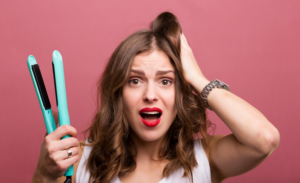In the pursuit of stylish and trendy hairstyles, we often overlook the potential damage that heat styling tools can inflict on our hair. The high temperatures generated by blow dryers, straightening irons, and curling wands can cause irreparable harm to the hair’s delicate structure, leading to dryness, breakage, and split ends.

Understanding Heat Damage
Heat styling tools work by manipulating the bonds within the hair’s protein structure, keratin. When excessive heat is applied, these bonds weaken and break, leading to a loss of moisture and elasticity. This damage is cumulative, meaning that repeated heat styling can make hair increasingly brittle and prone to breakage.
Identifying the Signs of Heat Damage
The signs of heat damage are often subtle at first, but they become more apparent with continued heat styling. Here are some common indicators of heat-damaged hair:
Dryness
Heat-damaged hair loses its natural moisture, making it feel dry, coarse, and straw-like.
Frizziness
Heat can disrupt the hair’s cuticle, the outer layer that protects the inner shaft. This disruption leads to frizziness, making hair difficult to manage and style.
Split ends
Heat damage weakens the hair shaft, causing it to split at the ends, giving the hair a ragged appearance.
Breakage
Heat-damaged hair is more prone to breakage, especially when brushed or styled.
Protecting Your Hair from Heat Damage
Fortunately, there are several proactive measures you can take to protect your hair from heat damage and maintain its healthy, vibrant appearance:
Minimize Heat Styling
The most effective way to prevent heat damage is to reduce the frequency of heat styling. Opt for air-drying whenever possible and explore natural hairstyles that don’t require heat application.
Embrace Heat Protectants
Always apply a heat-protectant spray or cream before using any heat-styling tool. These products form a protective barrier around the hair shaft, minimizing the impact of heat and shielding the hair from direct contact with extreme temperatures.
Adjust Heat Settings
Set your heat styling tools to the lowest temperature that effectively styles your hair. Avoid using excessively high temperatures, as these can cause more damage and amplify the negative effects of heat on your hair.
Condition Regularly
Regular conditioning helps replenish moisture and strengthen hair, making it more resilient to heat damage. Conditioning not only hydrates the hair but also helps repair existing damage and restore its natural elasticity.
Avoid Heat Styling Wet Hair
Never use heat styling tools on wet hair. Wet hair is more vulnerable to heat damage, and applying heat can cause significant breakage and structural damage to the hair shaft.
Deep Condition Regularly
Deep conditioning treatments provide intensive moisture and nourishment to the hair, helping to repair damage and restore its health. Conditioning treatments should be incorporated into your hair care routine every few weeks, especially if you heat style your hair regularly.
Trim Split Ends Regularly
Regular trims remove split ends, preventing them from travelling up the hair shaft and causing further damage. Split ends can act as a starting point for breakage, so trimming them regularly helps maintain healthy hair length and prevents further deterioration.
Protect Hair from Sun Exposure
Sun exposure can also damage hair, so it’s important to protect it with a hat or hair sunscreen. UV radiation from the sun can break down keratin, the protein that makes up hair, leading to dryness, loss of elasticity, and fading of colour.
Use a Silk or Satin Pillowcase
Sleeping on a silk or satin pillowcase reduces friction and prevents hair from becoming tangled or damaged during sleep. Cotton pillowcases can cause hair to snag and break, while silk or satin provides a smooth surface that allows hair to glide freely, minimizing friction and reducing damage.
Maintain a Healthy Diet
A healthy diet rich in vitamins and minerals provides essential nutrients for hair growth, repair, and overall health. Nutrients such as biotin, vitamin C, and iron play a crucial role in hair health, promoting strong, resilient hair that is less susceptible to damage.
